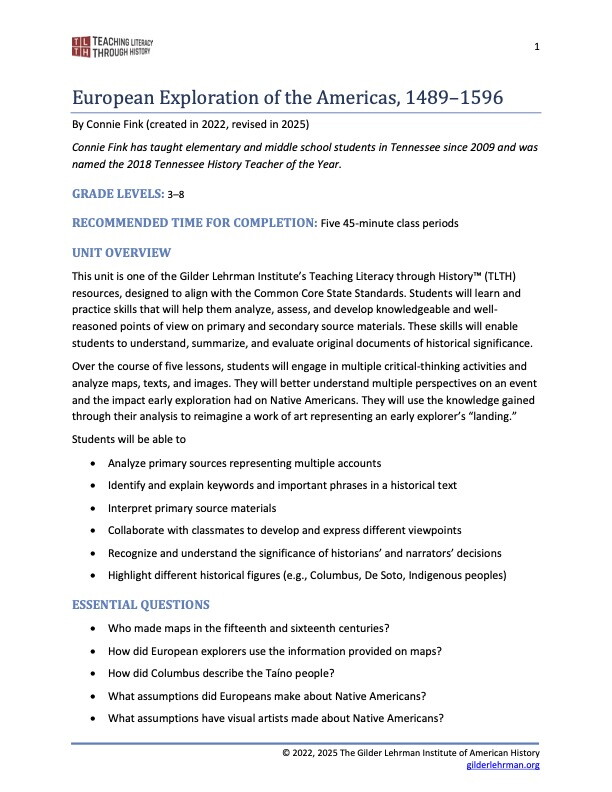Lesson by Connie Fink
Essay by Peter C. Mancall, University of Southern California
Grade Level: 3–8
Number of Class Periods: 5
Primary Era: The Americas to 1620

Lesson Plan Author: Connie Fink
Historical Background Essay by Peter C. Mancall, University of Southern California
CCSS.ELA-LITERACY.RI.3.1: Ask and answer questions to demonstrate understanding of a text, referring explicitly to the text as the basis for the answers.
CCSS.ELA-LITERACY.RI.4.1: Refer to details and examples in a text when explaining what the text says explicitly and when drawing inferences from the text.
CCSS.ELA-LITERACY.RI.4.2: Determine the main idea of a text and explain how it is supported by key details; summarize the text.
CCSS.ELA-LITERACY.RI.4.6: Compare and contrast a firsthand and secondhand account of the same event or topic; describe the differences in focus and the information provided.
CCSS.ELA-LITERACY.RI.5.6: Analyze multiple accounts of the same event or topic, noting important similarities and differences in the point of view they represent.
CCSS.ELA-LITERACY.RI.8.1: Cite the textual evidence that most strongly supports an analysis of what the text says explicitly as well as inferences drawn from the text.
CCSS.ELA-LITERACY.RI.8.7: Evaluate the advantages and disadvantages of using different mediums (e.g., print or digital text, video, multimedia) to present a particular topic or idea.
Who made maps in the fifteenth and sixteenth centuries?
How did European explorers use the information provided on maps?
How did Columbus describe the Taíno people?
What assumptions did Europeans make about Native Americans?
What assumptions have visual artists made about Native Americans?
Map of the World of Christopher Columbus, by Henricus Martellus, ca. 1489
Map of the Americas, America sive novus orbis respectu Europaeorum inferior globi terrestris pars, by Theodor de Bry and John White, 1596
Taíno Territory Map from Taíno: Native Heritage and Identity in the Caribbean created by Smithsonian Exhibits, 2017. Shown in Ranald Woodaman, “Bringing Taíno Peoples Back into History,” Smithsonian Magazine, December 28, 2019
Map of the Americas, Insulae Americanae in Oceano Septentrionali cum Terris adiacenibus, by Montanus, 1671
Letter from Christopher Columbus reporting on his first voyage, [March 4,] 1493
Broadside of Pope Alexander VI’s Doctrine of Discovery [Inter caetera], May 4, 1493
Landing of Columbus, based on a painting by John Vanderlyn, engraved by H. B. Hall, published by Martin, Johnson & Co., New York, 1856
Curate 757: Titus Kaphar, PBS, 2019 (9 minutes)
John Vanderlyn, Landing of Columbus, 1847, US Capitol
Titus Kaphar, Columbus Day, 2014, oil and mixed media on canvas, 67.75 x 90.75 x 4 inches
William Henry Powell, The Discovery of the Mississippi by De Soto, 1855, US Capitol